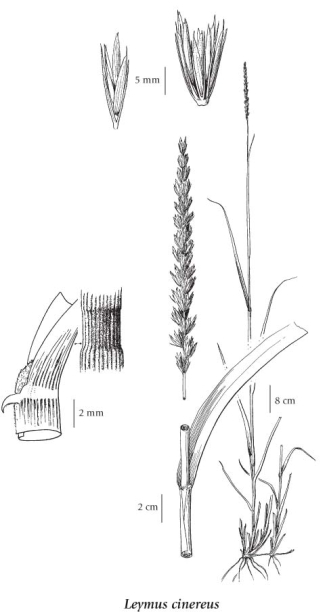Leymus cinereus (Scribn. & Merr.) Á. Löve
giant wildrye (basin wildrye)
Poaceae (Grass family)
Introduction to Vascular Plants
giant wildrye (basin wildrye)
Poaceae (Grass family)
Introduction to Vascular Plants
Species Information click to expand contents
General:
Perennial, coarsely tufted grass from short, smooth to strongly short-hairy rhizomes forming large clumps up to 1 m wide; stems solitary or in groups, usually finely short-hairy or smooth, especially near the nodes, 70-220 cm tall.
Leaves:
Sheaths open; blades tough, rough to sometimes finely hairy, mostly flat, (5) 8-20 mm wide; ear-shaped lobes usually well-developed at some leaf-bases; ligules usually short-hairy, membranous, (2) 3-7 mm long.
Flowers:
Inflorescence a stiff, erect spike, (9) 12-20 (25) cm long, sometimes compound, the lateral branches with as many as 5 or 6 spikelet-bearing nodes; spikelets sometimes paired, but usually 3 or more per node, (3-) 4- to 6-flowered, often 1 or more stalked; glumes narrow, awl-like, tapered from the base, 10-20 mm long, often as long as the spikelets; lemmas smooth to inconspicuously hairy, about 10-15 mm long, unawned or more usually awn-tipped, the awns 2-7 mm long; anthers 3-6 mm long.
Illustration click to expand contents

If more than one illustration is available for a species (e.g., separate illustrations were provided for two subspecies) then links to the separate images will be provided below. Note that individual subspecies or varietal illustrations are not always available.
Illustration Source: The Illustrated Flora of British Columbia
USDA Species Characteristics click to expand contents
Flower Colour:
Yellow
Blooming Period:
Early Spring
Fruit/Seed characteristics:
Colour: Brown
Present from Spring to Summer
Source: The USDA
Ecology click to expand contents
Ecological Framework for Leymus cinereus
The table below shows the species-specific information calculated from
original data (BEC database) provided by the BC Ministry of Forests and Range.
(Updated August, 2013)
The table below shows the species-specific information calculated from
original data (BEC database) provided by the BC Ministry of Forests and Range.
(Updated August, 2013)
| Site Information |
Value / Class |
||
|
Avg |
Min |
Max |
|
| Elevation
(metres) |
679 | 215 | 1885 |
| Slope
Gradient (%) |
12 | 0 | 78 |
|
Aspect (degrees) |
138 | 20 | 356 |
| Soil
Moisture Regime (SMR) [0 - very xeric; 4 - mesic; 8 - hydric] |
4 | 0 | 8 |
| Modal
Nutrient Regime
Class |
D | ||
| #
of field plots species was recorded in: |
61 | ||
| Modal
BEC Zone Class |
BG | ||
|
All BEC Zones (# of stations/zone) species was recorded in |
BG(31), BWBS(1), ESSF(2), ICH(2), IDF(8), MS(1), PP(8), SBS(2) | ||
|
Source:
Klinkenberg 2013
|
|||
Habitat and Range click to expand contents
Moist to dry, usually gravelly or sandy sites, ravines, streambanks and roadsides in the steppe and montane zones; frequent in SC BC, infrequent in SE BC; E to SK and S to MN, NM, AZ and CA.
Status Information click to expand contents
Synonyms click to expand contents
Synonyms and Alternate Names:
Aneurolepidium piperi (Bowden) Baum
Elymus cinereus Scribn. & Merr.
Elymus cinereus var. cinereus
Elymus cinereus var. pubens (Piper) C.L. Hitchc.
Elymus condensatus var. pubens Piper
Elymus piperi Bowden